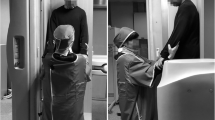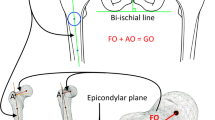Abstract
The present study was undertaken to serially observe the gait of patients after hip arthroplasty, using quantitative gait analysis, and to compare the gait in patients after total hip arthroplasty (THA) with the gait in patients after bipolar endoprosthetic arthroplasty (BEA). The subjects were 53 women with unilateral osteoarthritis of the hip. Thirty-one (mean age, 59.5 years) of them underwent THA and 22 (mean age, 58.0 years) underwent BEA. The stance time and characteristic parameters calculated from the vertical component of the floor reaction force (FRF) were analyzed via the use of a FRF plate. The stance time, which indirectly represents the walking speed, decreased for 1 year after THA and for 3 years after BEA. The decrease in this parameter was greater on the unaffected side than on the affected side. The deceleration effect and the weighing-off effect are useful indicators for the observation of gait recovery. Significant differences in these indicators between the unaffected and affected sides were seen for 1 year after THA and for 3 years after BEA. These findings indicate that the cadence and balance of the gait recovers earlier after THA than after BEA.
Similar content being viewed by others

References
Bateman JE, Berenji AR, Bayne O, et al. Long-term results of bipolar arthroplasty in osteoarthritis of the hip. Clin Orthop 1990; 251: 54–66.
Berman AT, Quinn RH, Zarro VJ. Quantitative gait analysis in unilateral and bilateral total hip replacement. Arch Phys Med Rehabil 1991; 72: 190–4.
Brady LP, McCutchen JW. A 10-year follow-up study of 170 Charnley total hip arthroplasties. Clin Orthop 1986; 211: 51–4.
Hattori T, Shimono T, Hasegawa H, et al. Gait analysis after total hip replacement for osteoarthritis. In: Japanese Society for Orthopaedic Biomechanics (JSOB) Proceedings of 1983 Annual Meeting of JSOB. Tokyo: Ishiyakushuppan, 1983; 5: 55–60 (in Japanse).
Hattori T. Current trends in gait analysis: Advanced techniques for data acquisition and analysis. In: Niwa S, Perren SM, Hattori T, editors. Biomechanics in orthopedics. Tokyo Berlin Heidelberg New York: Springer, 1992: 102–20.
Inman VT, Ralston HJ, Todd F. Human walking. Baltimore: Williams and Wilkins, 1981.
McConville OR, Bowman AJ, Kilfoyle RM, et al. Bipolar hemiarthroplasty in degenerative arthritis of the hip. Clin Orthop 1990; 251: 67–74.
Murray MP, Brewer BJ, Gore DR, et al. Kinesiology after McKee-Farrar total hip replacement: A 2-year follow-up of 100 cases. J Bone Joint Surg Am 1975; 57: 337–42.
Murray MP, Gore DR, Brewer BJ, et al. Comparison of functional performance after McKee-Farrar, Charnley, and Müller total hip replacement: A 6-month follow-up of 165 cases. Clin Orthop 1976; 121: 33–43.
Murray MP, Gore DR, Brewer BJ, et al. A comparison of the functional performance of patients with Charnley and Müller total hip replacement. A 2-year follow-up of 89 cases. Acta Orthop Scand 1979; 50: 563–9.
Okuno M. Clinical study on total hip replacement with gait analysis (in Japanese). J Yonago Med Assoc 1989; 40: 137–54.
Okuno M, Yamamoto K, Teshima R. Gait analysis of unilateral total hip replacement: Quantitative analysis of the vertical floor reaction force. In: Imura S, Akamatsu N, Azuma H, Sawai K, Tanaka S, editors. Hip biomechanics. Tokyo Heidelberg Berlin New York: Springer, 1993: 95–103.
Otsuka T, Yamamoto K, Teshima R, et al. Comparison of bipolar hip arthroplasty with total hip arthroplasty with bone grafts for osteoarthritis. Cent Jpn J Orthop Traumat 1994 37(5): 1299–300 (in Japanese).
Ouchi E, Terayama K, Watanabe S et al. Comparison between the floor reaction force and clinical evaluation in patients with total hip replacement. In: Japanese Orthopaedic Biomechanics Research Society (JOBRS). Proceedings of 1980 Annual Meeting of JOBRS. Tokyo: Ishiyakushuppan, 1980; 2: 119–24 (in Japanese).
Olsson E, Goldie L, Wykman A. Total hip replacement: A comparison between cemented (Charnley) and non-cemented (H.P. Garches) fixation by clinical assessment and objective gait analysis. Scand J Rehab Med 1986; 18: 107–16.
Phillips TW. The Bateman bipolar femoral head replacement. A fluoroscopic study of movement over a 4-year period. J Bone Joint Surg Br 1987; 69: 761–4.
Shaw JA, Greer RB III, Kollas CD. AML bipolar arthroplasty for degenerative hip arthritis. Orthopaedics 1987; 10: 1363–74.
Shima Y. Osteoarthritis of the hip joint (in Japanese). J Jpn Orthop Assoc 1971; 45: 813–4.
Stauffer RN, Smidt GL, Wadsworth JB. Clinical and biomechanical analysis of gait following Charnley total hip replacement. Clin Orthop 1974; 99: 70–7.
Stauffer RN. Ten-year follow-up study of total hip replacement. J Bone Joint Surg Am 1982; 64: 983–90.
Tanaka Y. Gait analysis of patients with osteoarthritis of the hip and those with total hip arthroplasty. J Jpn Orthop Assoc 1993; 67: 1001–13 (in Japanese).
Torisu T, Morita H, Tsumura H. Treatment of secondary osteoarthritis and rheumatoid arthritis by Bateman hip prosthesis. Arch Orthop Trauma Surg 1986; 105: 55–61.
Vasavada AN, Delp SL, Maloney WJ, et al. Compensating for changes in muscle length in total hip athroplasty. Effects on the moment generating capacity of the muscles. Clin Orthop 1994; 302: 121–33.
Wroblewski BM. Fifteen to 21-year results of the Charnley low-friction arthroplasty. Clin Orthop 1986; 211: 30–5.
Yamamoto S. Express method of floor reaction force data. In: Kubota T, Yamasaki N, editors Data manual of gait analysis. Floor reaction force. Tokyo: Therapeia, 1994; 45–56 (in Japanese).
Yamamuro T, Ueo T, Okumura H, et al. Five-year results of bipolar arthroplasty with bone grafts and reamed acetabula for osteoarthritis in young adults. Clin Orthop 1990; 251: 75–81.
Author information
Authors and Affiliations
About this article
Cite this article
Isobe, Y. Clinical study of arthroplasties for osteoarthritic hip by quantitative gait analysis: Comparison of total hip arthroplasty and bipolar endoprosthetic arthroplasty. J Orthop Sci 1, 34–43 (1996). https://doi.org/10.1007/BF01234113
Received:
Accepted:
Issue Date:
DOI: https://doi.org/10.1007/BF01234113



